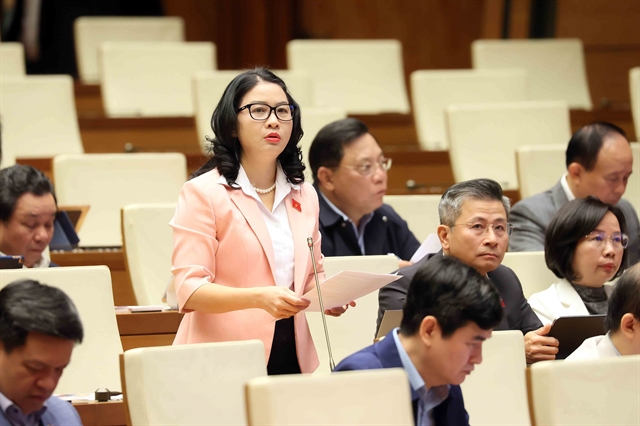 Business Beat
Business Beat


|
| Việt Nam is experiencing great hardship due to the prolonged COVID-19 pandemic that has hit most sectors of the economy. — Photo baodauthau.vn |
Compiled by Thiên Lý
British lender Standard Chartered Bank has cut its forecast for Việt Nam’s GDP growth this year to 4.7 per cent from its previous 6.5 per cent.
The Asian Development Bank has lowered its forecast from 6.7 per cent to 5.8 per cent.
The Việt Nam Institute for Economic and Policy Research expects only 4.5-5.1 per cent growth now, 1.2-1.5 percentage points lower than its earlier expectation.
Việt Nam is experiencing great hardship due to the prolonged COVID-19 pandemic that has hit most sectors of the economy.
In the first nine months of the year, the number of businesses that wound up permanently was 90,300, up 15.3 per cent from the same period in 2020, according to a report on the socio-economic situation in September by the General Statistics Office.
Only 3,899 new enterprises were incorporated in September, down 32.3 per cent from the previous month and 62.2 per cent from a year earlier.
Banks’difficulties
Most enterprises expect stronger support from banks in the form of low interest rate loans to revive their business activities after suffering heavy losses caused by COVID-19.
They urged the central bank to use monetary policies to cut lending interest rates.
Several commercial banks said supporting enterprises is their responsibility because of their symbiotic relationship, but they have their own difficulties too.
Phan Đình Tuệ, deputy director of Sacombank, told Đầu Tư & Chứng Khoán (Investment & Securities) that a1 percentage point cut in interest rates on outstanding loans for five or six months would decrease profits by over VNĐ1trillion or 40 per cent, and shareholders would not countenance this.
A senior official at the State Bank of Việt Nam (SBV) said due to the pandemic the banking sector’s bad debts ratio has been rising. It went up from 1.59 per cent at the close of last year to 1.78 per cent by April-end, and is expected to reach 4-4.5 per cent by the end of this year.
Nevertheless, economists have called for loosening monetary policy in addition to other measures to support the economy and prepare for a recovery by businesses once the pandemic is controlled.
The resultant increase in the supply of money will typically lower interest rates, generate more investment and generally act as a stimulus.
Analysts at SSI Securities Company said there is little inflationary pressure, which is an important condition for loosening monetary policy.
The consumer price index (CPI) only increased by1.82 per cent year-on-year in the first nine months of 2021, the lowest rate since 2016, while inflation for the year is only 0.88 per cent.
The analysts do not expect inflation to be a threat this year since consumer demand is still weak, and could possibly top out at 3 per cent for the year, well below the Government’s target.
But Ministry of Finance officials said inflation is expected to increase by 1 per cent a month on average and end up at around 4 per cent by year-end.
Economists suggested lowering banks’ reserve requirement ratio, or the proportion of deposits that credit institutions must keep with the SBV to mitigate risks, from the current 3 per cent. This elicited diverse opinions, however.
Its proponents, which included the director of a foreign bank, said this would help infuse more cash into economic activities, enabling faster recovery.
The director said lowering the reserve is a tool used by many central banks.
The 3 per cent ratio might appear to be low, but it represents an enormous sum of money, and reducing it even a little would improve banks’ liquidity significantly, enabling them to lend at reasonable interest rates, he said.
Dr Nguyễn Trí Hiếu, a respected banking and finance expert, told Đầu tư& Chứng khoán (Investment & Securities) that he too supported the idea of cutting the reserve requirement, and in fact suggested a dramatic 2 per cent cut.
He admitted however that a 1 per cent reserve rate would leave the central bank with very little wriggle room for regulating money supply, adding it, therefore, needs careful consideration.
Not in agreement
But other experts rejected the reserve rate cut proposal, saying it is too risky since the reserve is the ultimate weapon for the SBV to manage solvency and reduce risks.
The current ratio of 3 per cent is already low compared to many other countries, they pointed out.
A banking sector insider, who asked not to be identified, also dismissed the need for a cut, saying the market liquidity is already very high.
The inter-bank interest rate is very low at less than 1 per cent yet no banks are borrowing, indicating the high liquidity, he said.
A BIDV executive said đồng liquidity had improved significantly in the third quarter after banks earned VNĐ130-140 trillion (US$5.7-6.9 billion) from foreign exchange trading in the previous six months.
Another reason for the liquidity is the sharp slowdown in credit growth in recent months due to the central bank’s strict instructions to reduce lending to risky sectors and the impacts of the pandemic.
But deposit mobilisation has remained high, growing at 3-4 per cent in the case of deposits of less six months and 5 per cent in the case of six to 12 months.
In addition, the interest rate of government bonds with two-year term is just 0.7 per cent per month, lower than the interest rate of non-term deposits.
Inter-bank interest rates have also been on a downward trend, with overnight rates averaging 0.6-0.8 per cent.
With such favourable conditions, lenders are quite able to offer loans at low interest rates to support enterprises without the need for loosening monetary policy.
Dr Cấn Văn Lực, a member of the National Financial and Monetary Policy Consultation Council, said while lowering the reserve requirement does offer benefits, it is a relatively sensitive tool that could have unintended impacts on the market.
The central bank could instead use other tools like open market operations (OMO) and refinancing to support the market, he added.
Economist Dr Lê Xuân Nghĩa said the central bank has many ways to increase money supply and does not need to reduce the reserve requirement ratio.
He said to increase money supply the central bank could use OMO, which involves buying bonds from banks to inject cash into the system.
The SSI analysts said to cushion the impacts of COVID-19 and foster a quick recovery the central bank is likely to continue with Circular No 03/2021/TT-MHNN with some adjustments, which allows financial institutions to roll over and reschedule debt repayments to help customers affected by the pandemic.
It also allows banks and other financial institutions to not classify overdue debts from borrowers affected by COVID-19 as non-performing for a further six months, and delay the roadmap for reducing the cap on the use of short-term deposits for medium- and long-term loans. — VNS




